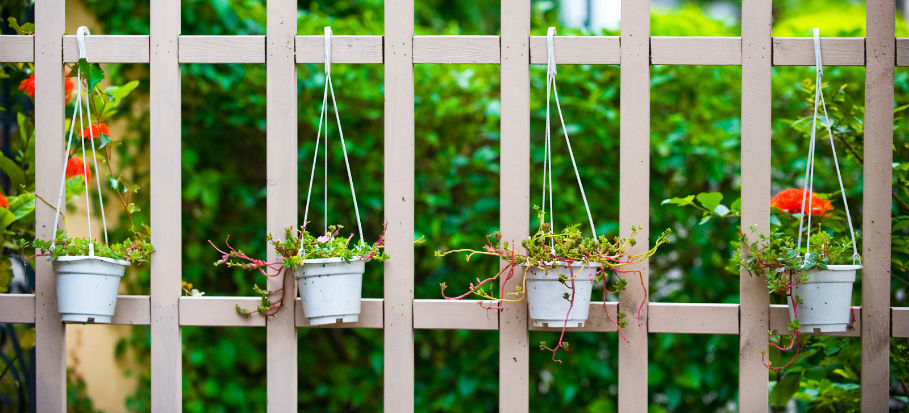Can’t sleep at night over a garden fence dispute with your neighbour? Or you’re just wondering in general about which side of the fence you’re responsible to maintain?
Well, you’ve stopped by here just in time. Our new post will clarify what exactly the UK garden fence law says about property boundaries and regulations when it comes to replacing, installing and maintaining your boundary fence.
We’ll also focus on how to determine which fence side is yours – left or right – and explore the different ways you can use to find out. And finally, you’ll learn about what to do to avoid an unnecessary fallout with your neighbour over your shared fenceline border.
So, let’s get started by looking into the current British garden fence legislation.
Garden fence law – which fence is mine?
Most likely, due to the precedent-based legal system in the UK, there isn’t a strict law regarding the boundary between two properties, be it a fence or a hedge, in terms of whose responsibility it is to install, repair or maintain it.
Also, there’s no set rule about whether you own the fence on the right or on the left-hand side of your house. You may be able to get this information from the conveyance deed, where there could be an already established boundary agreement regarding which fence side you are responsible for.
Still, your local council usually sets out the regulations for height and width of common boundary features that separate two adjacent properties. As a general rule, fences in back gardens should not be higher than 2 metres. To find out what the planning policy is for your area, simply contact your local planning office.
Interestingly, disputes between neighbours over the height of their common fence occur even when no garden fence law has been breached. This might happen because your neighbour has erected a fence that is too low, as he/she wants to gain more light exposure for their garden space.
You, however, wish to have the feature higher to protect your privacy. Then, you’ll have a couple of options. You can come to a mutual agreement – say, you get the neighbour’s permission to install a trellis on top and within the legal regulations. Or you can decide to exercise your rights, either way and install your own fence of the desired height (on your own property), right next to the fence, installed some time previously by your neighbour.
However, there are many other scenarios, outside the above-mentioned examples, when it comes to replacing or maintaining an existent shared boundary fence. And if you know from the start which side fence belongs to you, you can save yourself a lot of hassle and avoid unpleasant arguments with your neighbours.
How to tell which fence is yours – on the left or right-hand side?
So, let’s go back to the property deed and what you can learn from it. The legal document may explicitly state which homeowner is responsible for a said boundary fence – the left one or the right one. If there’s no such written arrangement, you can refer to the Land Registry plan and look for the symbol ‘T’.
More often than not, the Title plan will indicate with the letter ‘T’ (pointing inwards and placed next to the border fence) that you have to maintain and repair that garden boundary feature. Whether all property owners on the same street are responsible for their left side fences or for those, positioned on the right-hand side, will depend on the existing land use and development plans.
There might be a case where both property owners share their responsibility for maintaining the common boundary fence, indicated on the Title Plan with an ‘H’ (or two mirrored ‘T’-marks). Also, end-house homeowners may be responsible for both of their boundary fences – the left and the right one.
Sometimes, the title deed says nothing about the boundary between two detached properties, with regards to which owner should install, replace or repair the fence, or who is responsible for cutting the boundary hedge, for instance. The issue becomes even more complicated if the properties have not been registered with the Land Registry, a possibility that still exists in the UK, despite the latest Land Registration Act 2002.
In such cases, you can simply sign a new agreement with the proprietor of the neighbouring property and settle future disputes before they even occur. Or you can ask about, informally, and approach local businesses, the Post Office or other property owners in the area or on your street who have resided there longer than you and might have a better idea about established agreements.
Who owns the fence between two houses?
Considering that a joint statement from the Land Registry and Ordnance Survey states that a title plan shows only the general position of land boundaries, you’ll most probably find that the exact position of the legal boundaries is rarely shown on the Title plans, registered with the Land Registry.
This means that you can have a boundary fence, which is positioned on your neighbour’s land. For instance, there are also cases with semi-detached houses where the boundary house wall is also a party wall but it actually stands entirely on one of the property and it’s not part of the legal boundary between the two gardens. Still, more often than not, the boundary fence or wall forms the general legal border between two land plots.
But then, who does decide which party is responsible?
The responsibility for establishing which property owner is responsible for which fence is up to the discretion of the original landlord who’s divided his large property into smaller land plots. But as we’ve already noted, finding out who owns or has the duty to maintain the boundary fence may prove difficult even if you order the Title plan for your property through the Land Registry online service for a small fee of £3. This information is simply not always available.
And to make things even more interesting, did you know that under the UK law, you are not really obliged to have a fence, with a few exceptions?
No, we are not advising you to knock down your legally owned garden boundary fixture and end up having a tiff with your neighbour. On the contrary, you should simply learn and understand when you are required to build a fence by law.
When is it compulsory by law to install a fence?
People naturally feel more secure if their property is protected by a wall or a fence, be it to keep pets contained and children safe, to deter opportunistic burglars or to ensure some privacy for their family. But in effect, you are under no obligation to build a fence, unless your property is located next to a railway, a road or a highway.
Furthermore, if you own a livestock farm, you must also make sure that animals don’t stray off your property by installing a sturdy fence so that they don’t get hurt or cause damage elsewhere. Also, solid and secure fencing around disused and abandoned mines is mandatory by British Law.
So, there, we hope that you now have a deeper insight into fence regulations in the UK. As long as you know where you stand with your neighbours regarding fence ownership or maintenance responsibility, as well as understand your local planning policy, in terms of height and width requirements for boundary features, you have the freedom to build, replace or enhance your garden fixture without breaching any rules.
And of course, if you need professional assistance with your fence installation and repair needs, you can always entrust the Fantastic landscaping experts anytime.
Need a fence to be installed on your property?
We got it covered.
Is your neighbour planning to put up a fence without considering your opinion? Want to know if they’re in their right to do so? Find out in our blog post on the matter.
Disclaimer: Every piece of information here is meant for informational and educational purposes only. So please, do not use this as a definitive legal advice. Fantastic Services encourages you to seek authority professional counsel before you decide to act upon what you have read. For more information, check our disclaimer.
***
Did you find this article helpful? Or maybe, you want to share your recent garden fence dispute with a difficult neighbour? Then, do tell us about it in the comments below!
Image Source: Shutterstock/ by hxdbzxy
Enjoyed this article? Share with your friends!















